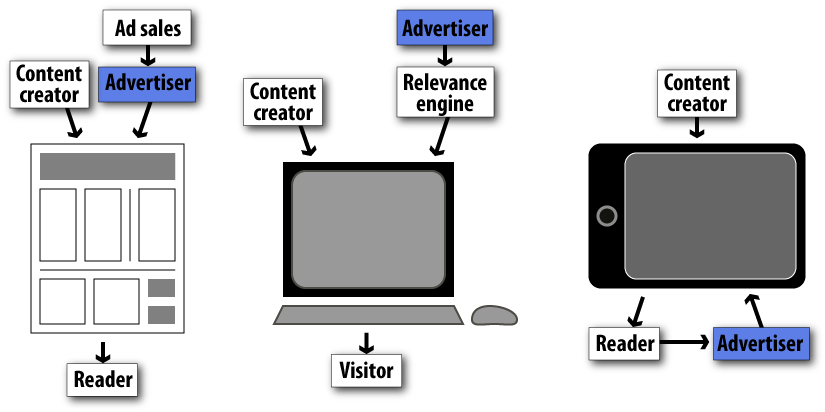
Newspaper and magazine publishers see the the arrival of tablet computers like the iPad as a salvation for their ailing industry. They expect it to lower delivery costs and move them from a once-a-day news source to a constant, immediate service.
The excitement is justified, but misdirected. If tablets do save publishing, it’ll won’t be because they’re digital or more up t. It’ll be because they make newspapers interactive, and in doing so, let any reader place an ad right on the page they’re reading, opening up an entirely new revenue stream.
A brief history of publishing
Broadcast media thrived when it was expensive. Only a few decades ago, to reach a large audience you needed a printing press, actors, a studio, or broadcasting licenses. The newspaper business model relied on two things: advertising revenue, and being the best way to get news. Newspapers billed by the physical unit — the printed issue — rather than by the content itself.
Craigslist and eBay all but destroyed the classified advertising market. National advertisers fled to the big, national papers, while the web showed the same advertisers that they could reach huge audiences cheaply while only paying for the ads that worked.
At the same time, readers were learning that there were better ways to get news faster, from Twitter, blogs, and news aggregators like Reddit.
Digital media to the rescue
Digital media is supposed to fix all this, driving the cost out of magazines a newspapers by doing away with all those costly atoms of wood pulp. Digital delivery also means a constant stream of news rather than a single, daily edition.
But I’m more excited about another aspect of digital media: making articles two-way can transform advertising. Today, buying online advertising is complicated. Self-serve, on-page advertising, enabled by the interactivity of tablets, could save newspapers.
Consider these three models:
In both print and online advertising, the advertiser isn’t the reader. But when newspapers move to tablets, the act of placing an ad can become an impulse buy.
Consider a local online newspaper that publishes an article about healthy food. The owner of a Chinese restaurant in the area may want to advertise on that article. What if they could place an ad simply by tapping a screen?
Self-serve ads will seduce small business owners. They know best what content is right for them, and the vanity of placing an ad easily is appealing. Companies like Next2news are already partnering with newspapers to make ad buying easy, and the New York Times has self-serve advertising that lets small business buy ad space in specific sections of the paper. But the time to sell an ad is when the advertiser is reading the article. Easy, on-page ad creation can create a spot market. And once a small business owner has placed an ad, the paper can reach out to that advertiser when related articles appear. It’s like Google Adsense for the layperson.
Has Apple already cornered this?
Apple’s already making waves in the advertising space. Apple says it will allow third-party ads to compete with their new iAd offering, but expressly forbids “the use of third-party software in Your Application to collect and send Device Data to a third party for processing”. Third-party tracking is an essential element of online advertising systems like Google Adwords, so with its licensing agreement Apple may already have crippled any competitors.
Two-way media holds tremendous promise for the publishing industry, but publishers will have to discard their one-way, broadcast-centric mindset. If they don’t, Apple will do it for them, the way it’s done with the music industry.







 @
@
 Tags:
Tags: 


 Like all images on the site, the topic icons are based on images used under Creative Commons or in the public domain. Originals can be found from the following links. Thanks to
Like all images on the site, the topic icons are based on images used under Creative Commons or in the public domain. Originals can be found from the following links. Thanks to